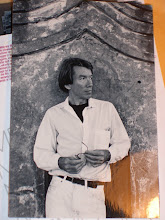Haymaking
It’s a big picture. It appears to be dead noon, under shrilling grasshoppers.
The heat looks heavy as a vice.
Off center, a peasant, wearing a pair of
eloquently battered boots, dozes under his hat.
A metal pail that once held a mid-day meal
pewters dully in the weeds.
Straw-yellow grays ride up to a line of hay ricks,
low hills, a sky pocked with little clouds.
A woman sits by the peasant's side, slouching forward,
half asleep, awkward, unaware of the observer,
for a moment lost in a wild country of thought
that fills her thick features,
her surprised and dismayed black eyes,
with . . . well, what might it be?
shock?
fear?
an unexpected, and unwelcome,
discovery? –
Whatever it is, it came to her as she drifted asleep
and thrust her awake with astonished pain.
There’s no way to know: the painter has told us
only what we see.
We know nothing but this fragment,
nothing before, and nothing after –
a quick snapshot in oil
on the magisterial canvas.
Then it’s gone.
You step back into the museum crowd,
and her blind, wondering face,
frozen on canvas for as long as the canvas will last,
disappears behind a wall of cloth and backs
into the gallery’s subdued glow,
and the sounds of shuffling feet,
and the bored, suspicious gaping of the museum guards,
and the scratching scratching scratching on paper pads of art students . . .
It does not disappear:
it follows you out, into the sun,
nagging, futilely, yet with an odd sweetness –
you ponder the woman in the picture as you might
the most obscure philosophical questions,
the metaphysics of loss, the holiness of unknowing,
or a lover’s impenetrable enigma:
a strangely enchanting question that has no answer.
The heat looks heavy as a vice.
Off center, a peasant, wearing a pair of
eloquently battered boots, dozes under his hat.
A metal pail that once held a mid-day meal
pewters dully in the weeds.
Straw-yellow grays ride up to a line of hay ricks,
low hills, a sky pocked with little clouds.
A woman sits by the peasant's side, slouching forward,
half asleep, awkward, unaware of the observer,
for a moment lost in a wild country of thought
that fills her thick features,
her surprised and dismayed black eyes,
with . . . well, what might it be?
shock?
fear?
an unexpected, and unwelcome,
discovery? –
Whatever it is, it came to her as she drifted asleep
and thrust her awake with astonished pain.
There’s no way to know: the painter has told us
only what we see.
We know nothing but this fragment,
nothing before, and nothing after –
a quick snapshot in oil
on the magisterial canvas.
Then it’s gone.
You step back into the museum crowd,
and her blind, wondering face,
frozen on canvas for as long as the canvas will last,
disappears behind a wall of cloth and backs
into the gallery’s subdued glow,
and the sounds of shuffling feet,
and the bored, suspicious gaping of the museum guards,
and the scratching scratching scratching on paper pads of art students . . .
It does not disappear:
it follows you out, into the sun,
nagging, futilely, yet with an odd sweetness –
you ponder the woman in the picture as you might
the most obscure philosophical questions,
the metaphysics of loss, the holiness of unknowing,
or a lover’s impenetrable enigma:
a strangely enchanting question that has no answer.


0 Comments:
Post a Comment
<< Home